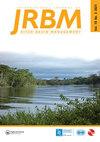Occurrence, toxicity load, pollution index and health risk assessment of trace elements in drinking water of two catchments in North-western Himalayas.
IF 1.9
Q3 WATER RESOURCES
International Journal of River Basin Management
Pub Date : 2023-11-14
DOI:10.1080/15715124.2023.2284183
引用次数: 0
Abstract
AbstractThe study focuses on the analysis of trace metals in drinking water from the Ganderbal and Budgam districts of Jammu and Kashmir. We have used high-resolution inductively coupled plasma mass spectrometry (HR-ICP-MS) to measure the concentrations of 31 trace metals in the water samples. The measured concentrations were then compared with the permissible limits set by the United States Environmental Protection Agency (USEPA), Bureau of Indian Standards (BIS), and World Health Organization (WHO). The results of the study indicate that arithmetic mean of several trace elements, including aluminum (Al = 781), chromium (Cr = 139), manganese (Mn = 41.86), nickel (Ni = 25.89), molybdenum (Mo = 1.30), cadmium (Cd = 36.86), and mercury (Hg = 67.65), in µg l-1 were found to have concentrations higher than their respective permissible limits. On the other hand, arithmetic mean of elements like beryllium (Be = 0.14), boron (B = 32.72), iron (Fe = 233), cobalt (Co = 1.79), copper (Cu = 10.71), arsenic (As = 0.93), selenium (Se = 3.13), strontium (Sr = 257), zinc (Zn = 43), antimony (Sb = 1.44), barium (Ba = 28.56), gold (Au = 0.91), and lead (Pb = 0.91) in µg l-1 were found to have concentrations below the permissible limits recommended by USEPA, BIS, and WHO. To assess the toxicity of the heavy metals in the study area, we calculated the Heavy Metal Toxicity Load (HMTL) for each metal. Based on these calculations, we concluded that only cadmium (Cd) and chromium (Cr) need to be removed from drinking water to ensure safety. The study also conducted a health risk assessment for both children and adults based on the measured concentrations of heavy metals. The assessment considered the ingestion and dermal contact routes of exposure. The Hazard Index (HI), which indicates the non-carcinogenic health effects, was found to exceed unity for only one element, cadmium (Cd), in both the children and adult groups. This suggests potential non-carcinogenic health risks associated with the ingestion of water and dermal contact. Additionally, the potential carcinogenic risk of cadmium (Cd) and arsenic (As) was identified and recommended for further attention. The study further evaluated the Heavy Metal Pollution Index (HPI) to assess the overall quality of drinking water in the study area. The HPI results indicated that the quality of drinking water was good, and the pollution levels in the study area were low. Overall, the findings of this study provide valuable information for water resource development and supply agencies. The results can be used as a baseline for future research and monitoring efforts in the region.Keywords: Heavy metaldrinking waterHealth riskGanderbal and BudgamDisclaimerAs a service to authors and researchers we are providing this version of an accepted manuscript (AM). Copyediting, typesetting, and review of the resulting proofs will be undertaken on this manuscript before final publication of the Version of Record (VoR). During production and pre-press, errors may be discovered which could affect the content, and all legal disclaimers that apply to the journal relate to these versions also. AcknowledgmentThe authors thank CSIR-National geophysical research institute, Hyderabad, India for providing lab facilities.DeclarationsEthical Approval:This declaration is not applicable.Competing interestsThe authors declare that they have no known competing financial interests or personal relationships that could have appeared to influence the work reported in this paper.zFundingNo source of funding is available.Data availabilityAll the data used in the study will be available from the corresponding author upon request.Author contributionAsiya Rahim conceptualized the idea of work, carried out experimental work in the field and laboratory, writing and editing of the manuscript. Savidh Khan, Asha Rani and Rayees Ahmed supervise the work and contributed in writing and reviewing. Vysetti Balaram provided the laboratory facility.喜马拉雅西北部两个集水区饮用水中微量元素的发生、毒性负荷、污染指数及健康风险评价
摘要对查谟和克什米尔邦甘德尔巴尔和布德甘地区饮用水中的微量金属进行了分析。采用高分辨率电感耦合等离子体质谱法(HR-ICP-MS)测定了水样中31种微量金属的浓度。然后将测量的浓度与美国环境保护局(USEPA)、印度标准局(BIS)和世界卫生组织(WHO)规定的允许限度进行比较。研究结果表明,在µg l-1中,铝(Al = 781)、铬(Cr = 139)、锰(Mn = 41.86)、镍(Ni = 25.89)、钼(Mo = 1.30)、镉(Cd = 36.86)、汞(Hg = 67.65)等微量元素的算术平均值均高于其允许限量。另一方面,铍元素的算术平均值(= 0.14),硼(B = 32.72),铁(Fe = 233),钴(Co = 1.79)、铜(铜= 10.71)、砷(= 0.93),硒(硒= 3.13),锶(Sr = 257)、锌(锌= 43)、锑(某人= 1.44),钡(Ba = 28.56),黄金(Au = 0.91)和铅(Pb = 0.91)在µg l - 1有推荐的浓度低于允许的限制构成,国际清算银行,。为了评估研究区重金属的毒性,我们计算了每种金属的重金属毒性负荷(HMTL)。根据这些计算,我们得出结论,只有镉(Cd)和铬(Cr)需要从饮用水中去除,以确保安全。该研究还根据测量的重金属浓度对儿童和成人进行了健康风险评估。评估考虑了摄入和皮肤接触暴露途径。表明非致癌性健康影响的危害指数(HI)发现,在儿童和成人群体中,只有一种元素镉(Cd)超过1。这表明潜在的非致癌健康风险与水的摄入和皮肤接触有关。此外,还确定了镉(Cd)和砷(As)的潜在致癌风险,并建议进一步关注。研究进一步通过重金属污染指数(HPI)对研究区饮用水的整体质量进行评价。HPI结果表明,研究区饮用水水质良好,污染程度较低。总体而言,本研究结果为水资源开发和供应机构提供了有价值的信息。研究结果可作为该地区未来研究和监测工作的基线。关键词:重金属饮用水健康风险甘宝和巴德免责声明作为对作者和研究人员的服务,我们提供此版本的已接受稿件(AM)。在最终出版版本记录(VoR)之前,将对该手稿进行编辑、排版和审查。在制作和印前,可能会发现可能影响内容的错误,所有适用于期刊的法律免责声明也与这些版本有关。作者感谢csir -印度海得拉巴国家地球物理研究所提供的实验室设施。伦理批准:本声明不适用。竞争利益作者声明,他们没有已知的竞争经济利益或个人关系,可能会影响本文所报道的工作。没有可用的资金来源。数据可获得性研究中使用的所有数据均可根据通信作者的要求获得。作者贡献asiya Rahim概念化工作思路,在现场和实验室进行实验工作,撰写和编辑手稿。Savidh Khan, Asha Rani和Rayees Ahmed监督工作,并参与写作和审查。Vysetti Balaram提供了实验室设施。
本文章由计算机程序翻译,如有差异,请以英文原文为准。
求助全文
约1分钟内获得全文
求助全文
来源期刊

International Journal of River Basin Management
WATER RESOURCES-
CiteScore
6.00
自引率
4.00%
发文量
48
期刊介绍:
include, but are not limited to new developments or applications in the following areas: AREAS OF INTEREST - integrated water resources management - watershed land use planning and management - spatial planning and management of floodplains - flood forecasting and flood risk management - drought forecasting and drought management - floodplain, river and estuarine restoration - climate change impact prediction and planning of remedial measures - management of mountain rivers - water quality management including non point source pollution - operation strategies for engineered river systems - maintenance strategies for river systems and for structures - project-affected-people and stakeholder participation - conservation of natural and cultural heritage
 求助内容:
求助内容: 应助结果提醒方式:
应助结果提醒方式:


